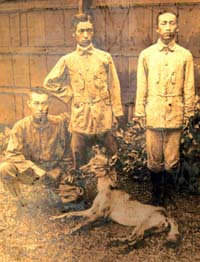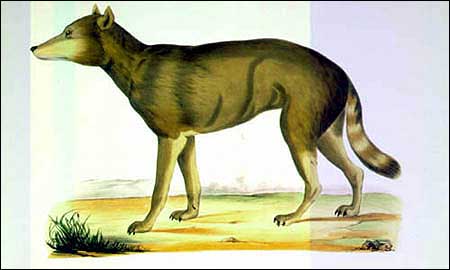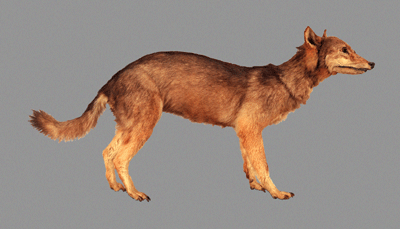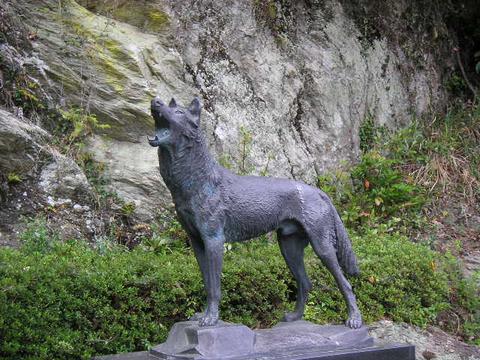Japanese Wolves – Part I: Honshu Wolf
Posted by: Loren Coleman on June 15th, 2009
Cryptomundo is proud to host another guest blog by Brent Swancer, this being a three part contribution reports and records of various mystery canids of Japan.
Japanese Wolves
Part I – Honshu Wolf
by Brent Swancer
“From the land of the subcompact car, we present the subcompact wolf.” ~ Matt Bille
This description by cryptozoology writer Matt Bille is fitting. The commonly thought to be extinct Honshu wolf (Canis lupus hodophilax) was the world’s smallest wolf, standing just a little over a foot at the shoulder.
Also known as the Hondo wolf, the yamainu or “mountain dog,” and the corruption of this word, shamainu, the Honshu wolf did not particularly resemble the grey wolf that most people are familiar with. In addition to the petite size, their bodies were more compact and narrower, with short, wiry hair and a thin, dog-like tail that was rounded at the end almost as if it was bobbed. They were also more low slung, with legs that were shorter in relation to their body length.
The Honshu wolf was quite dog-like in appearance, and in some ways had characteristics that bore more resemblance to some other types of wild canids like jackals or coyotes, and to “pariah” dogs such as dingoes, than to its Siberian wolf ancestors.
Although the Honshu wolf is currently most commonly classified as a subspecies of gray wolf, this is open to some debate. There are those who argue that the physical differences present were enough to consider the Honshu wolf as its own species instead of merely a miniaturized grey wolf. For instance Japanese zoologist Yoshinori Imaizumi, former head of animal studies at the National Science Museum and widely recognized as the foremost expert on Japanese wolves, has long held that the Honshu wolf should be given species status. There are even some who have questioned whether the Honshu wolf was a true wolf at all. The great diversity and plasticity of canids make it a bit unclear and tricky when it comes to precise taxonomical classification, so the matter is debatable. While the issue of the Honshu wolf’s taxonomical status may not be completely settled, whether a separate species or a subspecies, its story is a long and sad one.
The Honshu wolf was once a fairly common sight throughout its former range of the Honshu, Shikoku, and Kyushu islands of Japan. Residents of rural mountain farms and fields were well acquainted with the wolves, however the people’s reaction to them was not one of panic or fear. Far from being perceived as the evil or nefarious denizens of the forests that wolves were often depicted as in other parts of the world, the Honshu wolves were highly respected and even revered creatures. They were seen as mountain gods, and this divine nature can be seen in some other names for them such as magami meaning “true god,” and yama no kami , or “mountain god.” These wolves had a powerful image as benign protectors of the forest, which is mirrored in much of the folklore of rural areas concerning them.
This protective role can be seen in stories of the Okuri Ookami, or “Sending wolf” which tell of Honshu wolves keeping travelers from harm and guiding the way through the woods, ensuring their safe return home. The wolves were also thought to keep wild boar, deer, and other damaging pests away from crops, ensuring a good harvest. Farmers thought of the wolves as generous benefactors in other ways as well, as the animals would on occasion leave parts of their kills behind, which the farmers would repay with offerings of their own. The wolves were sometimes even said to help the old, poor, and infirm, with stories in some traditions telling of them bestowing wealth or curing sickness.
Even in death the Honshu wolves retained their protective powers. Parts of their bodies such as skulls, pelts, and bones often hung up to ward off evil spirits, and in some cases treated as objects of worship. Even the Honshu wolf’s scientific name, Canis lupus hodophilax, which was assigned by Temminck in 1839, is indicative of its role as a protector. Hodo means “path” or “way” in Greek whereas philax means “guardian,” so we get something like “guardian of the way.” The Japanese went through great lengths to show their respect and appreciation to these wolves. Offerings of food were set out for them to eat, prayers were said to them, and temples and shrines were constructed in their honor. To this day there are Shinto shrines devoted to the Honshu wolf in some areas of Japan. Although the wolves were occasionally hunted if they posed a threat, it was seen as bad luck to do so, and was said to invite divine retribution to anyone who did so.
The beginning of the end of the Honshu wolves is largely thought to have been heralded by a rabies epidemic that started in the mid to late 17th century and spread quickly through Japan. There were a large number of dead or sick wolves seen in the wilderness during this time, which is testament to the danger the disease posed. Rabies took a heavy toll on the wolf population of Japan, and had the further effect of negatively shifting people’s already changing perception of the wolves as well.
Modernization had already brought in new farming techniques and attitudes that did not leave much room for the wolves. New agricultural practices such as increased use of river valleys for farming rather than mountains meant less traditional reliance on the wolves for protecting crops. Increased livestock production also created new tensions between the wolves and the residents they were once seen as protecting. Rabies only aggravated these already shifting attitudes. Not only were the wolves seen as vectors of the disease, the idea of rabid wolves descending from the mountains into their village sparked in people a growing, newfound fear of the wolves. It began to be seen as acceptable to hunt them, and farmers began to kill wolves when they could, the threat of spiritual retribution all but forgotten. The divine image that the Honshu wolf had held for so long began to crumble as fast as their numbers.
In the early 1900s, a zoologist by the name of Malcolm Anderson had come to Japan to collect exotic animal specimens. On January 23, 1905, some village men in Nara prefecture brought in the carcass of a Honshu wolf which they claimed to have shot two days earlier near a woodpile as it chased a deer. The men initially had thrown the carcass away but then had remembered the foreigner collecting specimens, and figured that they could fetch a price for it. They were correct. Anderson purchased the remains and sent them back to London along with the carcasses of other animals he had collected such as deer, boar, and Japanese serow. This Honshu wolf specimen was taxidermed and put on display in the Museum of Natural History in London where it remains to this day.
It was the last of its kind.
Or was it?
Stay tuned for Part 2, where we will look at the answer to this question and continue the story of the Honshu wolf.
END
About Loren Coleman
Loren Coleman is one of the world’s leading cryptozoologists, some say “the” leading living cryptozoologist. Certainly, he is acknowledged as the current living American researcher and writer who has most popularized cryptozoology in the late 20th and early 21st centuries.
Starting his fieldwork and investigations in 1960, after traveling and trekking extensively in pursuit of cryptozoological mysteries, Coleman began writing to share his experiences in 1969. An honorary member of Ivan T. Sanderson’s Society for the Investigation of the Unexplained in the 1970s, Coleman has been bestowed with similar honorary memberships of the North Idaho College Cryptozoology Club in 1983, and in subsequent years, that of the British Columbia Scientific Cryptozoology Club, CryptoSafari International, and other international organizations. He was also a Life Member and Benefactor of the International Society of Cryptozoology (now-defunct).
Loren Coleman’s daily blog, as a member of the Cryptomundo Team, served as an ongoing avenue of communication for the ever-growing body of cryptozoo news from 2005 through 2013. He returned as an infrequent contributor beginning Halloween week of 2015.
Coleman is the founder in 2003, and current director of the International Cryptozoology Museum in Portland, Maine.

















Interesting piece, thanks for sharing. Looking forward to part 2 🙂
Intriguing as always. I eagerly await part 2!
– I am one of those people. The whole concept of “species” as defined as “a group of animals capable of interbreeding to produce fertile offspring” has to be thrown out the window when it comes to canids, especially to wolflike canids such as dogs, wolves, coyotes & jackals. Wolves, coyotes & jackals can all interbreed with dogs and with each other to produce fertile puppies. There are credible reports of dogs being bred to dholes, and even foxes (I don’t know if the offspring from those intergeneric breedings were fertile. I doubt it).
The native dog breeds of Japan bear a strong resemblance to the Japanese wolves and are thought to descend (at least in part) from them.
Wild canids can be extremely cryptic. In the area where I live, there are red and gray foxes, and coyotes. Lots of coyotes. But you rarely see them, even as roadkill. The vegetation is very lush, and the mountainous, rocky terrain with its steep slopes and gullies provides a lot of cover.
If coyotes can exist here without many people even being aware of them (until they start losing cats and livestock), I don’t see it as a stretch to believe that at least a remnant population of Honshu wolves could survive to this day.
agreed kittenz…interbreeding capability and taxinomical classification are no longer the most viable ways to identify new species. if available, DNA analysis will yield undeniable truth. not only can an animal’s place on the tree of life be identified, it’s closest relatives and ancestors can be traced. this is the most accurate means of identification today. without DNA, placement is hypothetical.
look forward to part 2!
Kittenz- If you are are interested in the relation of Japanese dog breeds to Honshu wolves, you’ll like Part 2 of this series, where I will bring that up. I won’t say too much here in that respect yet but it is quite interesting.
Anyway, it is not only canids that defy the traditional definition of species. Some mammals such as bears can produce fertile offspring. For instance, polar bear/brown bear hybrids have produced fertile offspring, and Kodiak bear/ polar bear hybrids have been shown to be fertile as well. The full extent of fertility between members of Ursus has not been completely established, but all but a few species can interbreed with each other without a problem.
Many species of cat can produce fertile offspring too, especially small species of feline. For example, there have been fully fertile hybrids between domestic cats and European wildcats. Also domestic cat and steppe cat Felis caudata crosses have been shown to be fertile, as well as hybrids from domestic cat and jungle cat crosses, to name a few.
Many types of fish can produce viable hybrid offspring as well.
In fact, the whole definition of species as being strictly “two groups of animals that cannot produce fertile offspring,” is becoming pretty old fashioned and not very useful for modern taxonomy. With what we are learning about genetics and species plasticity, the old definition just doesn’t seem an adequate yardstick for taxonomical classification anymore. We are finding that the boundaries between species are a lot more malleable and plastic than was once thought and so there are other criteria that are considered beyond the simple ability for two animals from different species, or even different genera, to produce fertile offspring.
That being said, I have to admit that I am a “splitter” (for those not familiar with this word, it means someone who favors breaking animals down into very specific taxonomical categorizations), and think the Honshu wolf meets certain other criteria for being classified as its own species.
Anyway, I hope everyone will enjoy this series on Japanese wolves.
Mystery man and Kittenz…interesting exchange regarding these species, as always. Coincidentally in today’s Science Daily there is a report regarding species level taxonomical designation and moose (N.American vice European) from Univ. Alaska Fairbanks. Surprising and enlightening and maybe some bearing on this discussion of wolves and allied species of canines, the 2nd part of which I’m eagerly anticipating. Cheers.
Great post, as always, Mystery_Man.
BTW, I must admit I did not know fish can produce hybrid offspring. I always learn something new every day here. Thanks, Brent.
And I do agree with Kittenz that it’s not “stretching” to suggest that the Honshu may still exist in a remote corner of Japan. Hopefully, that is so.
Is this the wolf in question in an episode of The X Files? The one where a cryptozoologist supposedly captured and brought back a wolf from Japan, only to find out that he was possessed by the spirit of the wolf and became a werewolf. If it is, then they needed to do some more homework. The dog they used didn’t even look close to the pics above.
Great job! I look forward to the other parts.
maeko responds:
June 15th, 2009 at 7:16 am
“…interbreeding capability and taxinomical classification are no longer the most viable ways to identify new species. if available, DNA analysis will yield undeniable truth… this is the most accurate means of identification today. without DNA, placement is hypothetical.”
I completely agree, the old definition just will not do.
However, people must be careful blindly assuming DNA results will be the solution, as it stands.
DNA does not discretely package subjects into species for us.
it merely reveals similarities and differences, often reported in precentages, between the genetic information of subjects.
it is up to us to determine how to apply this and create the standards for species differentiation.
in other words, if we rely on DNA results, then what becomes the new definition, or standard, for speciation?
do we have a percentile value of difference established as the benchmark?
i.e. any two subjects with greater than 6.78% genetic dissimilarity are defined as separate species (or greater), with 6.78% or less are then classified as subspecies?
(this value is purely arbitrary for illustrative purposes).
as it stands, that magic number is not established, and all DNA results can give us is a “wow, those two things are awfully similar” moment.
the process of evolution is a constant differentiation of forms by the most subtle and slight of changes.
lifeforms with very high repopulation rates could easily alter themselves out of their named species within a single human’s scope of observation.
how genetically similar are the nile crocodiles of today compared to those during the reigns of the ancient pharaohs of egypt?
how genetically similar are we to those same humans?
of course we are still the same species, but there would undeniably have been appreciable genetic alteration in the intervening time.
nature does not have the concept of species as we do.
just like metres and kilograms, if we wish to measure life out into species, then we need to establish solid criteria that we have to invent.
DNA alone makes no statements.
mystery_man responds:
June 15th, 2009 at 7:33 am
“…I have to admit that I am a “splitter” (for those not familiar with this word, it means someone who favors breaking animals down into very specific taxonomical categorizations)”
me too. and i hope once we establish a quantifiable standard for measuring speciation using DNA, we will see some taxonomic reshuffling. 🙂
If it’s possible to be both a splitter and clumper, I’d be in that camp, and since I’m neither a specialist nor a scientist and am not trying to cast in bronze the taxinomical apple cart while it’s still in the process of rolling along with new discoveries and understandings almost as regular as a metaphorical metranome, I’ll try to be familiar with as many perspectives as I can keep sorted in my brain. I love a good argument so long as the terms are mutually agreed upon…something particularly problematic in the world of crypto where specualtion can run rampant if not grow wings.
Good point, Thylo, about how the DNA that we’re using to identify species, as it stands now, is largely delivered as a percentage, or as a statistical quantity. It does look like the future might be able to consider the actual sequence for an organism, molecule by molecule, and then it will get really interesting. Even so, from the standpoint of the biologist who’s area of inquiry is more about population, will still be more interested in the effect than the actuall degree of difference or relatedness..where we split hairs, hares, and heirs, english being the precise language that it is.